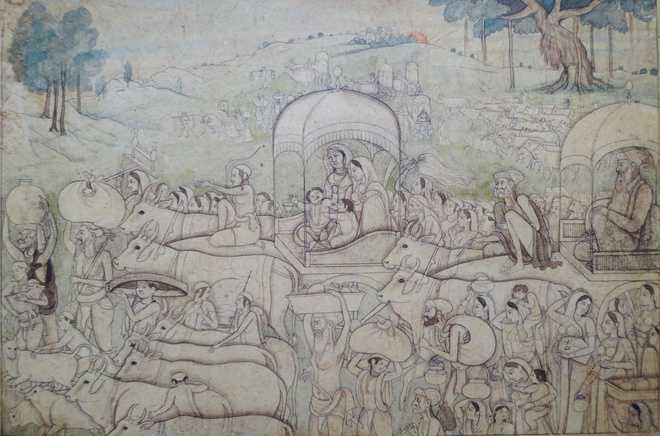
Nanda, his family and tribesmen, moving from Gokul to Vrindavana, Drawing from a Bhagavata Purana series. Pahari, ca. 1775
BN Goswamy
On the string of time, today’s society is beaded with yesterdays’ society; on the same string hangs our ancient culture, with its wealth of literature, music, science and philosophy, as a priceless jewel.
…..
Great artists do not come to build ideals of beauty, but to explore such structures as may grow from time-to-time, and push them into the running stream of life where Beauty and non-Beauty flow together. Art is man’s response to the overpowering mystery of nature. — Abanindranath Tagore
One knows a great deal about the illustrious Tagore family, for there is such a great deal out there to know. Rabindranath (1861-1941) — the iconic Gurudeva: poet, philosopher, musician, painter, visionary, patriot — is the one we know the most about perhaps: his stature in the world of the arts; his Gitanjali, which brought him the Nobel Prize in Literature; the countless plays and novels and poems he wrote; the Sangeet that he virtually invented and which bears his name to this date; the Knighthood which was conferred upon him by the British, but which he returned in protest against the Jallianwala Bagh massacre; Shantiniketan, the ashram and the university which he founded; the slew of paintings which he started producing at such a late stage of his life. The impression Rabindranath left behind not only on Bengal but the whole of India remains large, and deep.
We also know a fair amount about his two distinguished nephews — Abanindranath (1871-1951) and Gaganendranath (1867-1938) — the former both a most influential artist and teacher, and virtual founder of the Bengal School of Painting; the latter a sensitive painter who responded in his own fashion to the world-art of his times. Together, the two, while moving towards the revival, at least a re-appraisal, of traditional art, also founded the Indian Society of Oriental Art. They were in the thick of it: the art movement of the time. What we know very little about, however, is the fact that the two younger Tagores were also avid collectors. They had, in fact, amassed, in the early years of the last century, a very large collection of traditional Indian drawings and paintings. This collection has, for the most part, remained hidden from general view for long, very long, years.
All that is going to change, fortunately. In another few days, a large exhibition is going to open at the famed LD Museum in Ahmedabad. Featured in it will be the Tagore collection which has been with the Kasturbhai Lalbhai family, having been acquired from the Tagores by Seth Kasturbhai, famous industrialist and philanthropists of the city, as also a rasika in the true sense of the word. The viewer is going to be led into the exhibition by a very impressive, stately catalogue put together by Prof Ratan Parimoo, director of the Museum. There will be treasures on view, one can be certain.
The formation of the collection, much as its acquisition, is a story in itself. For it takes us back to those heady times when so much had begun to happen in Calcutta. Intellectual stirrings, something like a renaissance, could be felt in the air. Moving about in the background, but occasionally emerging to occupy centrestage too, were celebrated names, like Ananda Coomaraswamy, EB Havell, and Kakuzo Okakura. Coomaraswamy, a true seeker, always in search of roots, and beginnings, had become close to the whole Tagore clan. He was inordinately fond of drawings — a favourite line of his was by the great English painter and poet William Blake: “The merit of a picture is the same as the merit of a drawing … he who draws his drawings, draws his picture” — kept buying works and published very early on, in 1910 and 1911, books on Indian drawings in which figured some works that already belonged to the Tagores. Havell, Principal of the Calcutta School of Art, and a revivalist-connoisseur, often led Abanindranath towards ancient Indian art and thought, and was a major influence on him. The brilliant Japanese scholar, Okakura — one has to remember here that internationalism was like a mantra in the Tagore circles — who always spoke of the ‘Ideals of the East’ and moved between Japan, Boston and India with great ease, also picked up Indian works, out of admiration.
When you add to this the fact that traditional paintings were not hard, in fact were often extremely easy, to acquire, and there were dealers, some based in Patna or Calcutta, others from far off places like Amritsar, who could bring piles of drawings and paintings to the very doors of potential buyers, one can imagine a situation in which collections, sizeable collections, could be built. One comes upon names of dealers like Abdul Khaliq, Radha Krishna Bharany, even Ishwari Prasad of Patna, who were active at that time. The result? Both Abanindranath and Gaganendranath began picking up works with great interest and avidity.
How did they choose, and what were their interests? It is hard to say, but the collection they built was extensive, and greatly varied. Being artists themselves, the two must have been very curious about techniques, themes and motifs, the reach of imagination, As it kept forming, however, one could see in it a bewildering mélange: Padshahs and Nawabs, Sufis and Derwishes, lissome maidens and handsome warriors; the studied elegance of Mughal paintings, the evanescent beauty of Pahari drawings, the easy informality of Sikh works. Not necessarily interested in classifying styles and sub-styles, Gaganendranath kept them in beautifully bound albums, each marked with the name of the subjects to be found in it, and so on.
The works were not however to remain in Tagore hands forever. As Parimoo records, in 1930, Gaganendranath suffered a stroke, and Abanindranath was overtaken by a sense of deep loss and melancholy. The fate of this priceless collection became uncertain in these circumstances, and, after considerable deliberation, it was offered to Seth Kasturbhai. From Calcutta, the collection shifted eventually to Ahmedabad, moving from caring hands to caring hands.



























